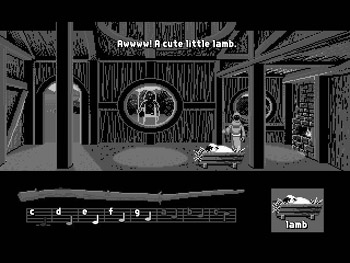User Interface
User Interface
The interface in Loom is the epitome of simplicity, requiring players only to use their mouse and a single button. This, of course, makes the game very easy to learn and play for anyone at all familiar with a point-and-click system. This is in sharp contrast to many other adventure games, particularly the text-only adventures that had their heyday in the 1980s, including those that Moriarty had worked on. Nearly all of these games include a text parser which, ideally , allows players to enter whatever they want their character to do using natural language. Get book, Northwest, Open door with red key, and Look at painting are all examples of common commands from such text adventures. The limitation, unfortunately , was that many text parsers did not feature a complete set of the words in the English language, nor could they properly parse complex sentences. In fact, Infocom, the company that published Moriarty s Wishbringer , Trinity , and Beyond Zork , had the best text parser available by far. Yet the parser could still be challenging to use. Especially frustrating was when players knew exactly what they needed to do in the game, but they could not find the correct words to say it. Not to mention the fact that, for the system to work, players are required to spell everything correctly, a task at which few people excel. At the very best, one could become familiar with the idiosyncrasies of a text parser over time, but to a beginner the dominant feeling was one of frustration.

Loom keeps its interface as simple as possible by having the player interact with the game-world by using only the mouse.
Indeed, in the excerpt from the manual included earlier, the text parsers of old are derided. It seems that Moriarty was ready to move on to a more intuitive and easy-to-learn interface. Of course, one of the primary requirements of any interface is that it be easy to learn. The challenges players face should be in the game-world itself, not in the controls they have to manipulate in order to affect that game-world. Maniac Mansion had already used an entirely point-and-click interface, and Loom borrowed a lot from that game s mechanics, at least in terms of world navigation. Players could move their character, Bobbin Threadbare, through the world simply by clicking on the location where they wanted him to go. This seems quite obvious to modern gamers who have seen countless point-and-click movement systems in games ranging from Diablo to Grim Fandango to Command & Conquer . Part of the beauty of the system is its obviousness; once one has seen it in action, one cannot imagine how else you would direct a character using a mouse.
However, Maniac Mansion and other graphical adventures had still included verbs for players to click on. These verbs were basically a holdover from the text parsers; players would click first on an object and then on a verb in order to manipulate that object accordingly . Some other graphical adventures had replaced these verbs with icons that functioned identically to their text counterparts. Of course, in many cases there was only one verb/icon that would have any useful effect on a particular object, hence making the functionality of the icons largely extraneous. Loom eliminated the verbs entirely to allow users to simply double-click on a given object and then have the game figure out what they wanted to do with the object. If players double-clicked on a person, Bobbin Threadbare would talk to him or her. If it was an object with text on it, Bobbin would read it. If it was a sheep, he would poke it. The game works with players instead of against them, allowing players to perform only the actions that will be useful to them. The double-click is an obvious extension of the single click. The single click moves Bobbin to that object; a double-click has him attempt to use it. Obviously, this input system is also identical to how point-and-click is used on the Macintosh and Windows platforms, so it has the added advantage that players are likely to understand it before they even start playing. The lesson to be learned here is that copying input ideas from established standards is almost always better than making up something new. Whatever slight gain one might achieve with a new input method is almost always negated by the frustration players experience while trying to learn it.
EAN: 2147483647
Pages: 189